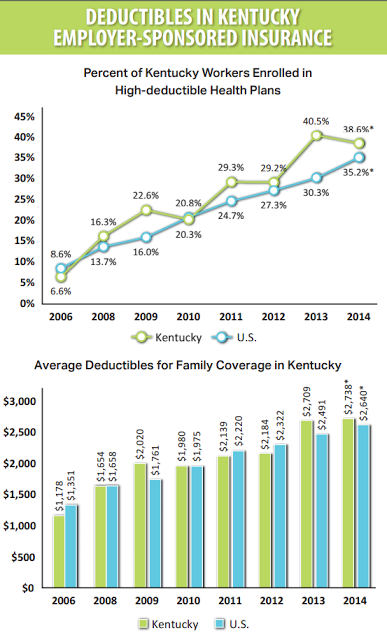Kentuckians increasingly covered by high-deductible health plans

Six times as many Kentucky workers were enrolled in high-deductible health insurance plans in 2014 as in 2006, reflecting a national trend, says a report for the Foundation for a Healthy Kentucky. As a result, the average amount they had to pay before their insurance kicked in more than doubled, from $1,178 in 2006 to $2,738 in 2014.
Most of the 93,666 people enrolled in the Kynect health-insurance exchange, where premiums are federally subsidized, chose high-deductible plans for this year.
“Employers and consumers often choose high-deductible health plans in return for lower monthly premiums,” said Susan Zepeda, president and CEO of the foundation. “Research shows that these plans lead to decreased health-care spending as consumers who have to pay up front for care become more conscious of costs. But consumers on high-deductible plans also tend to use fewer preventive services, such as vaccinations and cancer screenings, that save money — and lives — in the long run. And these plans can make it more difficult for Kentuckians with low incomes or chronic conditions to pay their medical bills, leading them to delay or skip essential health care.”
In 2014, 38.6 percent of the 2.4 million Kentuckians who get health coverage at work were enrolled in plans considered “high deductible” by the Internal Revenue Service: $1,250 for single and $2,500 for family coverage in 2014. In 2006, high-deductible plans covered 6.6 percent of enrollees. Nationally, enrollment in high-deductible plans rose from 8.6 percent in 2006 to 35.2 percent in 2014.
 |
| Figures are for Open Enrollment Period 3, for this year. |
In Kentucky, 60 percent of this year’s Kynect enrollees chose the “Silver” plan, which has a median deductible of $3,500 for an individual and $7,000 for a family, with median monthly premiums of $255 and $585.
“While the percentage of U.S. employees on health insurance plans with deductibles at any level grew from 66.4 percent in 2006 to 83.9 percent in 2014, the percentage of such plans in Kentucky was much higher than in the country as a whole in 2006, but has remained relatively stable since then (90 percent in 2006, 90.3 percent in 2014),” the foundation said in a news release.
The report was created by the State Health Access Data Assistance Center at the University of Minnesota as part of a 34-month study of the impacts of federal health reform in Kentucky.
